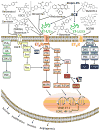Endothelins and their receptors in cancer: identification of therapeutic targets
- PMID: 21251982
- PMCID: PMC3109221
- DOI: 10.1016/j.phrs.2011.01.002
Endothelins and their receptors in cancer: identification of therapeutic targets
Abstract
Endothelins and their receptors are important in normal physiology, but have been implicated in various pathophysiological conditions. Members of the so-called "endothelin axis" are dysregulated in a wide range of human cancers, opening the door for novel anticancer therapies. Established cancer chemotherapeutic agents and drugs that target specific components of the endothelin axis have been combined with promising results, but more work is needed in this area. The endothelin axis affects numerous signaling pathways, including Ras, mitogen activated protein kinases, β-catenin/T-cell factor/lymphoid enhancer factor, nuclear factor-κB (NFκB), SNAIL, and mammalian target of rapamycin (mTOR). There is much still to learn about optimizing drug specificity in this area, while minimizing off-target effects. Selective agonists and antagonists of endothelins, their receptors, and upstream processing enzymes, as well as knockdown strategies in vitro, are providing valuable leads for testing in the clinical setting. The endothelin axis continues to be an attractive avenue of scientific endeavor, both in the cancer arena and in other important health-related disciplines.
Copyright © 2011 Elsevier Ltd. All rights reserved.
Figures

Similar articles
-
The endothelin axis in cancer.Int J Biochem Cell Biol. 2008;40(8):1443-51. doi: 10.1016/j.biocel.2008.01.022. Epub 2008 Feb 1. Int J Biochem Cell Biol. 2008. PMID: 18325824 Review.
-
Targeting endothelin axis in cancer.Cancer Treat Res. 2004;119:293-314. doi: 10.1007/1-4020-7847-1_14. Cancer Treat Res. 2004. PMID: 15164883 Review. No abstract available.
-
The endothelin axis in cancer: the promise and the challenges of molecularly targeted therapy.Can J Physiol Pharmacol. 2008 Aug;86(8):473-84. doi: 10.1139/Y08-058. Can J Physiol Pharmacol. 2008. PMID: 18758494 Review.
-
The endothelin axis: emerging role in cancer.Nat Rev Cancer. 2003 Feb;3(2):110-6. doi: 10.1038/nrc990. Nat Rev Cancer. 2003. PMID: 12563310 Review.
-
Endothelin receptor antagonists: rationale, clinical development, and role in prostate cancer therapeutics.Curr Oncol Rep. 2006 Mar;8(2):108-13. doi: 10.1007/s11912-006-0045-1. Curr Oncol Rep. 2006. PMID: 16507220
Cited by
-
Endothelin Receptor Antagonists: Status Quo and Future Perspectives for Targeted Therapy.J Clin Med. 2020 Mar 18;9(3):824. doi: 10.3390/jcm9030824. J Clin Med. 2020. PMID: 32197449 Free PMC article. Review.
-
Endothelin-1 promotes survival and chemoresistance in chronic lymphocytic leukemia B cells through ETA receptor.PLoS One. 2014 Jun 5;9(6):e98818. doi: 10.1371/journal.pone.0098818. eCollection 2014. PLoS One. 2014. PMID: 24901342 Free PMC article.
-
Repurposing of the Drug Tezosentan for Cancer Therapy.Curr Issues Mol Biol. 2023 Jun 11;45(6):5118-5131. doi: 10.3390/cimb45060325. Curr Issues Mol Biol. 2023. PMID: 37367074 Free PMC article. Review.
-
Endothelin causes transactivation of the EGFR and HER2 in non-small cell lung cancer cells.Peptides. 2017 Apr;90:90-99. doi: 10.1016/j.peptides.2017.01.012. Epub 2017 Jan 31. Peptides. 2017. PMID: 28153500 Free PMC article.
-
Differential somatostatin, CXCR4 chemokine and endothelin A receptor expression in WHO grade I-IV astrocytic brain tumors.J Cancer Res Clin Oncol. 2018 Jul;144(7):1227-1237. doi: 10.1007/s00432-018-2645-1. Epub 2018 Apr 25. J Cancer Res Clin Oncol. 2018. PMID: 29696364 Free PMC article.
References
-
- Khimji A, Rockey DC. Endothelin – biology and disease. Cell Signal. 2010;22:1615–25. - PubMed
-
- Good TJ, Kahook MY. The role of endothelin in the pathophysiology of glaucoma. Expert Opin Ther Targets. 2010;14:647–54. - PubMed
-
- Karkoulias K, Lykouras D, Sampsonas F, Drakatos P, Canova S, Tsoukalas G, Spiropoulos K. The role of endothelin-1 in obstructive sleep apnea syndrome and pulmonary arterial hypertension: pathogenesis and endothelin-1 antagonists. Curr Med Chem. 2010:1059–66. - PubMed
-
- Leonard MG, Gulati A. Repeated administration of ET(B) receptor agonist, IRL-1620, produces tachyphylaxis only to its hypotensive effect. Pharmacol Res. 2009;60:402–10. - PubMed
Publication types
MeSH terms
Substances
Grants and funding
LinkOut - more resources
Full Text Sources
Research Materials
Miscellaneous

